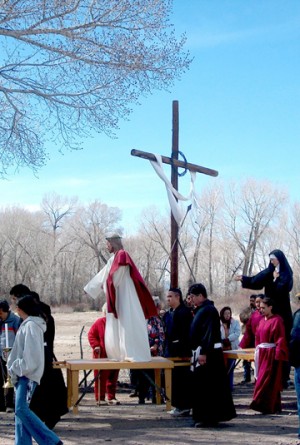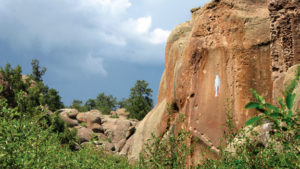by Charles F. Price
Editor’s note: In part one of this piece, which ran in the Feb. 2010 issue, the author documents a visit by the notorious gunman to Salida and attempts to determine whether it served as stopping off point for a secret trip to Arizona to “dispose” of John Peters Ringo.
In Denver during the extradition wrangle, a goofy con-man named Perry Mallon, pretending to be sheriff of Los Angeles County, California, briefly got the authorities to detain Doc on a trumped-up murder charge, but was soon discredited. While Doc was embroiled with Mallon, Bat Masterson, then marshal of Trinidad and a friend of Wyatt’s, slyly filed a bogus larceny complaint against Doc, hoping that case would give him legal dibs on Holliday over Mallon (this was a favor to Earp since Masterson actually despised Doc). The larceny case was slated for a hearing in Pueblo on July 11 — thus Doc’s trip through Salida.
So who started the rumor, which Tanner repeated, that Wyatt, Holliday and their partners killed Ringo? Well, Wyatt Earp for one. Over the years of his long life — he passed away in 1929 — he boasted, then denied, then boasted again, that he and the others had done the dirty deed. No doubt he wished he’d killed Ringo and the wish had sometimes become the source of belief. To his credit, when he finally dictated his life story to biographer Stuart N. Lake shortly before his death, he came clean and abandoned the lie, which few had ever believed anyway. His publicity-hungry widow, Josephine Sarah Marcus Earp, then revived it and kept it alive until she passed away in 1944 — — or so her self-proclaimed biographer insists, though he himself has been largely discredited.
Lies can serve insidious purposes. For some reason the story of the Earp-Clanton feud in Tombstone has been twisted by bitterly partisan researchers willing to fake evidence, pass off lies as facts, and spin the historical record until the truth, always elusive under the best of circumstances, is now nearly impossible even to approach. Of course any writer studying a frontier feud is tempted to take sides and shape the material to fit the version he or she favors. But no other Wild West conflict — not New Mexico’s Lincoln County War, Colorado’s Lake County War, Arizona’s Pleasant Valley War, nor the Sutton-Taylor feud of Texas — has been as subject to distortion as the Tombstone affair, so much so that one partisan researcher once showed up at a symposium packing a six-shooter and daring others to disagree with his interpretation of the “facts.”
Adocates so passionate can be persuasive if not intimidating, and maybe it isn’t Tanner’s fault that she fell for the Earp-Holliday-Ringo fantasy. Even so, it would have been easier to excuse her had she not trimmed the July 8 Mountain Mail account of Holliday’s arrival in Salida to cut out Osgood and Robinson, making it appear that Doc was alone and ready to hit the vengeance trail at once with Wyatt and his cronies. Or that she neglected to quote the line saying the three men were expected to spend “several days” in Salida — an inconvenient fact that undercuts her theory of Doc’s immediate pell-mell ride into New Mexico via Poncha Pass and the San Luis Valley. The complete newspaper report was cited in Gary L. Roberts’ definitive 2006 The Life and Legend of Doc Holliday. Roberts debunks the Earp-Holliday connection to Ringo’s death, as do most reliable researchers and historians.
Still, it would be interesting to know some of the details of Doc’s Salida visit. Would he and his friends have taken a horse-drawn hack from the stone depot and over the Arkansas on the F Street bridge, or would they have walked? As they crossed, would they have glanced upstream to see the diagonal truss bridge that carried the DR&G extension to Poncha Springs? Was the river running high? The footings of the two bridges might have still been clogged by debris and the town before them probably looked a little battered — the previous Tuesday a monster rainstorm had swept through the valley, improbably sparing Poncha Springs but sending a “heavy flood down the gulch by Mix & Beebe’s brick yard,” damaging the track between Salida and Nathrop and piling up an “immense amount of sand” near the approach to the Cleora bridge.
Would they have checked into the Hawkins Hotel and made use of the hot and cold baths at the Salida Bath Rooms next door (the renowned Monte Christo wouldn’t be built for another year)? Would they have shot billiards in Rowe and Thompson’s Club Room Saloon? Taken a few drams at Dell Crane’s Gold Room or Jessie Brown’s Place or the Railroad Saloon? Bucked the faro tiger in Jack McCall’s?
Whatever they did, Doc would’ve drawn the eye. The tuberculosis that would finally kill him in Glenwood Springs in 1887 was then in remission, and while in Gunnison earlier he’d cut quite a figure, especially in contrast to the dour Earps. The reporter for the Gunnison Daily wrote he was “dressed in a dark close fitting suit of black, and wore the latest style of round top hat. His hair was seen to be quite gray, his moustache sandy, and his eyes a piercing dark blue.” Doc’s handshake was “strong free and friendly.” The gray hair was premature — Holliday was only thirty-one.
Judd Riley, a policeman who saw Doc and the Earps in Gunnison, took note of Holliday’s fondness for strong drink in an interview he later gave to Stuart Lake. Doc, he recalled, “was the only one of the gang that seemed to drink much, and the minute he got hilarious, the others promptly took him in charge and he just disappeared.”
Riley also provided a vivid glimpse of Wyatt:
“The bunch was well heeled and went armed. Earp was a fine looking man, tall with a drooping mustache that curled at the ends. He was quiet in manner and never created a bit of trouble here, in fact he told us boys on the police force we could call on him if we needed help at any time. He was a dead shot, I guess, always wore two guns high up under his arms, but he never used them here.”
Wyatt Earp was a sure-fire hard case but he had a soft spot for Doc. Many years later, while he was giving a deposition in a civil court case, Holliday’s name came up in a way that implied Doc was a bad character. Earp snapped: “He never had no trouble in Tombstone outside of being in this street fight with us. Then on one occasion he got in trouble with part of the combination that was against me … and, of course, that made them pretty sore against Holliday. But they knew that I was Holliday’s friend and they tried to injure me every way they could.”
John Behan, the sheriff of the county where Tombstone was located, “stood in with this tough element,” Earp ranted, “the cowboys and stage robbers and others, because they were pretty strong and he wanted their vote. Whenever they would get a chance to shoot anything at me over Holliday’s shoulders they would do it. So they made Holliday a bad man. An awful bad man, which was wrong. He was a man that would fight if he had to.” At that point the court cut off Wyatt’s tirade. That was 45 years after the OK Corral fight and Wyatt was still anxious to defend his old partner.
However Holliday spent his days in Salida, he left there in time for his engagement in Pueblo. As ordered, he appeared in court on Tuesday, July 11, 1882. Tanner’s claims to the contrary notwithstanding, the court record makes it clear he was present “in his own proper person as well as his counsel, W.G. Hollings, Esq. (emphasis added)” and not skulking from Lordsburg into the Chiricahuas to bushwhack John Ringo. Holliday pleaded “not guilty in manner and form as charged in the indictment, and puts himself upon the county, and the said people, by their said attorney, say they do the like.” Anticlimactically, the case was continued.
Tanner’s account, on the other hand, contends Doc was not physically in court and only Hollings was there in his absent client’s behalf. Thus, she writes, “it appears that Doc was with the Earps, eager to find Ringo and complete their mission.” In a footnote she claims the phrase “appearing in his own person (for some reason leaving out the word ‘proper’)” was “common pro forma legal language that could be used even if the defendant were absent from the court.” Lawyers may dance as they wish upon the head of this particular pin, but most historians believe Holliday was in Pueblo that day.
Tanner’s book is a valuable and absorbing account of Holliday’s life — especially as regards his family connections back in his native Georgia. It’s a pity the author allowed herself to be led by the mischief of others into the improbable box canyon of a Ringo murder conspiracy. Doc Holliday is interesting enough without embellishment.
However that may be, the continuance of his case left Doc with open options. He decided to visit another Central Colorado town somewhat more celebrated, and certainly more lively, than Salida — Leadville. And Leadville would prove very, very hard on him.
The author wishes to extend special thanks to Jeffrey Donan, director of the Salida Regional Library, and particularly to Martha Quillen, library assistant, who laboriously pieced together a multitude of microfilm images and battled a balky copier to furnish him a copy of the appropriate page of the July 8, 1882 Mountain Mail.
Charles F. Price is a writer living in Burnsville, NC. He has published five works of historical fiction and has just finished a new novel about the murder raid of the Espinosas though Central Colorado in 1863. He has maintained a lifelong interest in the history of the American West.

